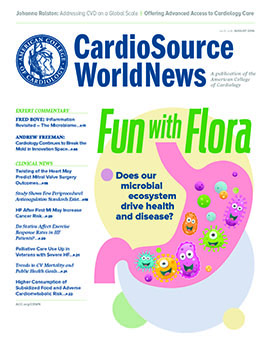Editor’s Corner: Inflammation Revisited – The Microbiome | Alfred A. Bove, MD, PhD, Editor-in-Chief, CardioSource WorldNews
CardioSource WorldNews | We like to think that, at some point in time, we come to a revelation that provides insight into health and disease processes, and then develop strategies to either support the process if it improves health or create methods to stop or slow the process if it is detrimental to health. An important example of this process is the evolution of our understanding of atherosclerosis itself; namely, as a lengthy process involving lipid deposition in the vascular wall, plaque formation, narrowing of arteries that supply vital organs and, ultimately, occlusion of the blood supply to an organ or tissue with subsequent ischemic injury.
We have developed drugs to retard the atherosclerotic process, lifestyle changes that contribute to a reduction of atherosclerosis, and have better ways to manage comorbidities that seem to contribute to the process. Yet our success in eliminating these disorders is limited. In spite of our therapies to reduce the atherosclerotic burden, we still see a significant amount of pathology.
The observations raise the question of whether there is another process that we are not accounting for that contributes to the burden of disease. Based on data accumulated over the last decade, research tells us we are missing the important role that inflammation plays in chronic tissue injury.
The connection between inflammation and atherosclerotic disease is complex. It involves inflammatory networks that link the atherosclerotic process to the autonomic nervous system, bone marrow, spleen, and other organs. We have come to understand the atherosclerotic process as one involving a number of inflammatory cells that secrete pro-inflammatory cytokines that in turn aggravate the cell injury caused by the inflammatory process, producing a systemic inflammatory milieu that favors atherothrombotic events.
However, for clinicians, the challenge has been translating this inflammatory hypothesis of atherosclerosis into something of clinical value. The early logical choice was corticosteroids but this approach was abandoned amidst concern for impaired wall healing resulting in cardiac rupture. Selective and nonselective nonsteroidal anti-inflammatory drugs (NSAIDs) have been analyzed, but with the exception of aspirin, all of these agents increase the risk for acute myocardial infarction, especially in those patients known to have ischemic heart disease. With current therapies for atherosclerosis unable to target these cellular inflammatory mechanisms, the situation is ripe for exploitation with new methods to reduce atherosclerosis risk.
Bacteria and the Microbiota
An important concept that has evolved from our understanding of the cellular milieu that exists in the body is the knowledge that a variety of bacteria dwell in our tissues; some may provide benefit to stable organ function, while others may aggravate the inflammatory process to cause chronic disease. These are classified as microbiota.
Gut microbiota include more than 1,000 bacterial species in an adult. The microbiota can be protective against allergic reactions, inflammation, and cardiac pathological states while adverse changes in the microbiota result in chronic pathological conditions that include the cardiovascular system. Future targets for therapy of chronic cardiac disease will include therapies that enhance favorable microbiota and suppress unfavorable species.
Bacterial colonies that exist in the colon in particular can confer immunity or alter bacterial flora to improve organ function. One example: the use of lactobacilli as therapy for Clostridium difficile infection. In this case, the microbiota replace pathogenic bacteria with friendly bacteria that help to control the C. difficile colonization. Other studies suggest that gut microbiota can exert beneficial effects on metabolic diseases. A new pathway for research in this area is to evaluate the effects of antibiotics on gut bacteria that can influence metabolic function.
Future therapies for patients with acute and chronic diseases are likely to involve drugs that alter the gut microbiota to improve organ and tissue function. Dysfunction of gut microbiota has been shown to induce metabolic endotoxemia, provoking an inflammatory response that, in turn, can cause insulin resistance, metabolic syndrome, obesity, diabetes, inflammatory bowel disease, and altered immunity. Figuring out those interventions that favor growth of favorable microbiota can lead us to new therapies allowing us to approach these disorders in an entirely new way.
Some foods may be atherogenic because of unfavorable effects of microbiota on food metabolism. For example, meat and eggs seem to stimulate the production of adverse microbiota. The production of trimethylamine and its metabolite TMA-N-oxide (TMAO) are thought to accelerate the atherosclerotic process. Here again we uncover a target for therapy of atherosclerotic disease that incorporates new concepts only recently understood. Similar concepts carry over to cardiomyopathy and heart failure. We thought we knew how to manage metabolic diseases, heart failure, and atherosclerosis. With the growing understanding of microbiota and their interactions, these discoveries add an important new dimension to our concepts of health and disease, and offer potential new therapies for conquering many of our chronic diseases.
Alfred A. Bove, MD, PhD, is professor emeritus of medicine at Temple University School of Medicine in Philadelphia, and former president of the ACC.

|
Read the full August issue of CardioSource WorldNews at ACC.org/CSWN |
Keywords: CardioSource WorldNews, Arteries, Atherosclerosis, Lipids
< Back to Listings
